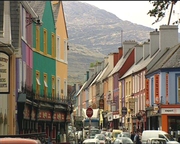Land is at the heart of Irish history and society. This documentary explores the history and development of the tourist town of Kenmare and its association with the great landed estate of Lansdowne.
This is a story from rural Ireland. The subject is land, how it passes from generation to generation – in this instance, from a colonized part of Ireland to native ownership. Land in Ireland was and is a most prized asset.
The location of this film is the thriving tourist town of Kenmare and a rural landscape that stretches from South Kerry to the Beara Peninsula. This territory once belonged to the Marquis of Lansdowne and was known for centuries as the Lansdowne Estate.
The Lansdowne family to this day represents a pinnacle of the English aristocracy. The fabulously wealthy and well-connected Lansdownes saw South Kerry and their summer home, Derreen House as their “Jewel in the Crown”. The estate in Kerry amounted to 96,500 acres in the wild and majestic scenery that stretches from Kenmare to Beara with blocks of land scattered around the towns of Waterville, Cahirciveen, Killorglin and Lixnaw.
‘Land is Gold’ is a history portrait of the Lansdowne Estate from pre-famine times to the founding of Saor Stat Eireann, and on to the present when Kenmare is a vibrant aspect of Ireland’s Celtic Tiger, listed by Fortune Magazine as one of the Top 10 places in the world for recreation and retirement.
The key figure of the Lansdowne Estate in the second half of the 19th Century was the agent, W.S. Trench, famous and infamous in the annals of landlordism in Ireland.
Trench was an Anglo-Saxon Protestant writer and documenter, who ruled South Kerry on behalf of his master, Lord Lansdowne, with ruthless, uncompromising efficiency. He knew every man, woman and child in the area – the animals on the land, down to every last chicken – were documented by Trench.
Trench and his son, Townsend reserved the rights to fishing, gaming and the seafood of Kenmare Bay. In short, Trench and his son ruled South Kerry, body and soul.
All of Trench’s documents about the estate and its people are lodged today in Derreen House. This unique collection is the basis of Gerard Lyne’s prize winning history study.
This film explores the economic, cultural and religious clashes between the Protestant philosophy of the post-industrial English and the ancient Gaelic mind-set of the oppressed Catholic native population. We study and analyze how a system allowed a tiny minority to shape the destiny of a vast majority.
The film documents the slow, painful transfer of land over decades – from absentee landlordism to native ownership through the Land League; Sinn Fein; War of Independence; and finally the Land Commission (1923) of the new Irish Independent State.
The film explores South Kerry’s disillusion with native government after the passing of the Lansdowne reign. The Treaty and events of 1921 had not meant “Land for the People” as the Land League and Sinn Fein had preached.
In addition, Kenmare and environs witnessed in 1922, a civil war, fought with ferocity, the murder of Free State officers in the town and the burning of Derreen House.
Finally, the film will explore how “sleepy old Kenmare” has become – since 1985 – a dynamic tourist destination.
Neidín is the Irish for Kenmare. The town could perhaps justly be called Lansdowne Town, for the Earl and his agent Trench developed this rural town – today’s shops, buildings and churches are the legacy. W.S. Trench created the tourist industry in Kenmare, a fact now acknowledged on film by its leading citizens.
The ghosts of the Lansdownes and the Trenches remain for all who wish to delve into this unique Irish history that has reverberations for every townland in this state.
Land is the subject of the film. Contributors are native and local. It is their story. No stars, no celebrities. In the local, in terms of historical perspective, we view national history.
The principal participant is Gerard J. Lyne, Keeper of the Manuscripts at the National Library of Ireland.
Lyne is a native of Lauragh, Kenmare. Lyne was born on a farm that was once property of Lord Lansdowne and is now his family home.
Gerard Lyne’s prize-winning history of the estate is the work of 20 years research presenting a comprehensive portrait of Kerry society over a century.
BACKGROUND:
For centuries, the Lansdowne family has made Bowood House, Wiltshire, their primary residence. Today, the ninth earl, Charles Lansdowne resides in this great house. His city residence is Lansdowne House, Berkeley Square. A summer residence is Derreen House and gardens near Kenmare. The Lansdowne family still enjoys the rights to fishing and shooting in addition to some ground rents in the town of Kenmare.
The Lansdownes were part of the power and the glory of the British Empire. One Earl was a Prime Minister, another Viceroy of India. The family had vast estates in England and Scotland. The Irish estates included parts of Laois, Monaghan, and Kerry. The Lansdownes were connected through marriage with the Earls of Shelbourne, who owned land in what we now know as Dublin 4 and the Irish Rugby Headquarters.
‘LAND IS GOLD’ WAS PRODUCED BY SEAN O’ MORDHA OF ARABY FILMS FOR RTÉ TELEVISION.
